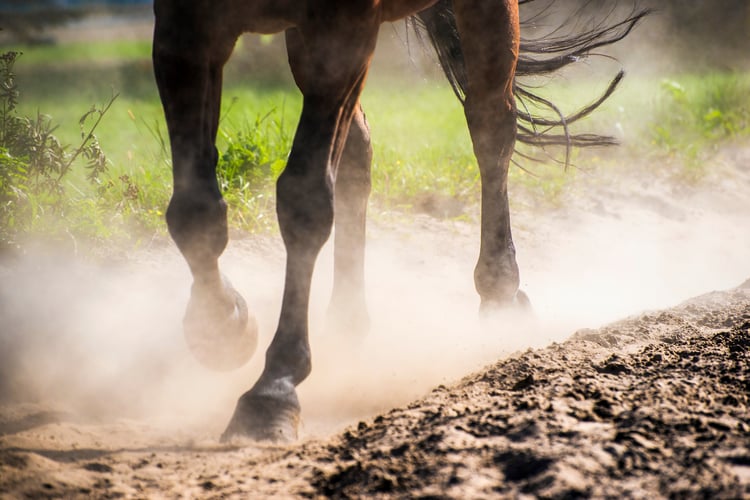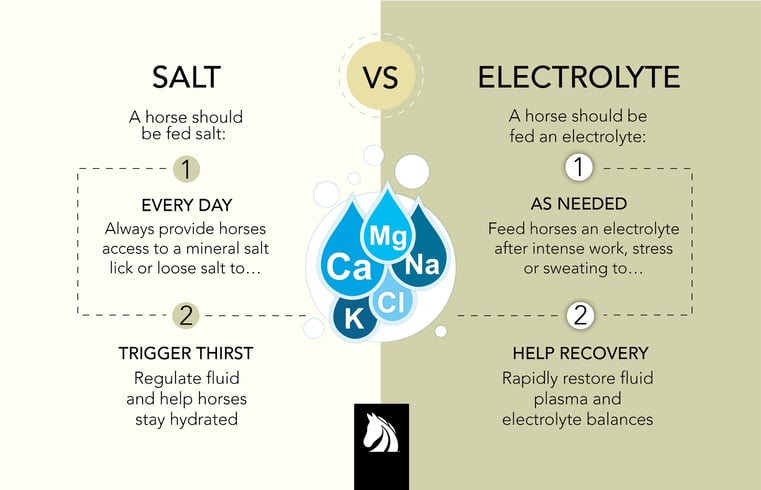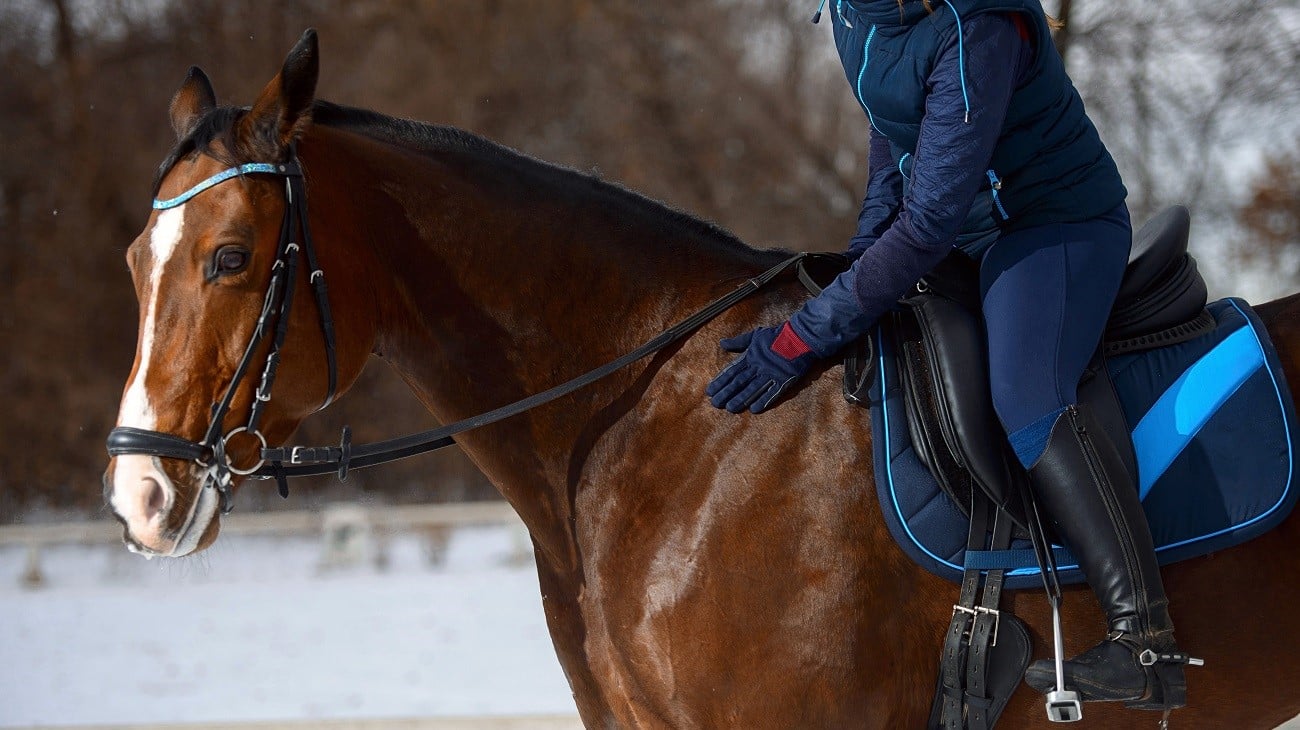A Vet's Guide to Feeding & Caring for Horses in Hot Weather
July 07, 2023
A Vet's Guide to Feeding & Caring for Horses in Hot Weather
What do horses need when cold weather gives way to warmer days? We asked veteran veterinarian, Dr. Beth Blevins. She’s practiced animal medicine in the Mission Valley of western Montana for 37 years treating mostly horses and cattle. Get her expert help on how to prepare your horses for warmer weather in this post!
Warm weather is upon us, along with the opportunity to climb in the saddle again and travel more with our equine companions. But as the seasons change, so do our horse’s needs. Spring and summer are the time to evaluate horse nutrition, fitness level, and water intake.
Need some help navigating the changes that come with horses and hot weather? Take advice from a vet! Here are four spring horse care items to be on top of to ensure your partner stays healthy heading into summer and the season is more pleasant.
Quick Content Guide
- Five helpful spring horse conditioning tips.
- Advice on what to feed horses in summer.
- Effects of spring grass on horses and why you should limit grazing.
- When to use salt vs. electrolytes for horses in hot weather.
- How to get your horse to drink water on the road.
Getting Your Horse in Shape
As you begin warm-weather activities, keep in mind your horse needs time to adjust to a new routine, workload, and... like the rest of us, heat. Hot weather and humidity by themselves are stressors for horses. Add an increased exercise regimen or training schedule and you’ve doubled the strain.
So how do you safely get your horse fit for the riding season? If you’ve ridden consistently through the winter, you can probably ramp up spring training quickly. If your horse has spent the cold months taking it easy in the barn or paddock and is out of shape, you’ll need to gradually increase the duration and intensity of exercise.
“Just as people cannot get off the couch and exert themselves maximally without at least getting sore,” Dr. Blevins said, “a horse cannot come off winter pasture and carry a rider to the top of a mountain without risk of health problems.”
Beware of Tying Up in Horses
Some deconditioning risks include sore muscles, tendon or ligament damage, and tying up—a painful condition often triggered by dehydration and strenuous exercise in an unfit horse.
“Tying up is a serious complication of exertion,” Blevins said. “The horse cramps, sweats and becomes reluctant to move. Muscle breakdown can also occur, releasing myoglobin from the muscles that can travel to the kidneys and cause severe damage.”
Horse Tying Up Treatment
If your horse ties up, allow it to stand quietly to rest its muscles. If you notice red or reddish-brown colored urine, that’s a sign your horse is in danger of muscle and kidney damage. A call to a vet for intravenous fluids is the prescribed treatment at that point. Blevins noted the best solution for tying up, however, is to prevent it before it happens.
“Keeping your horse hydrated and gradually conditioning to increased exercise is the safest way to prevent tying up and get ready for a summer of riding,”
Tips for Spring Horse Conditioning
Most of us spend the winter longing for the time when we can start riding horses in spring and summer. Here are five vet-recommended suggestions for safely getting your horse back in shape:
- Assess your horse’s body condition with the help of a vet or trained equine professional and make necessary adjustments to diet or exercise.
- Consider riding in the early morning to reduce heat stress. Or if you live in an area with high humidity, try riding in the evening. While nighttime temps may be higher than morning, relative humidity is usually much lower.
- Don’t skip warm-up and cool-down routines during workouts.
- Offer your horse water at intervals during a workout to help your partner stay hydrated.
- If your horse overheats, hose it with tepid water to cool down in hot weather and assist with sweating and cooling.
 Feeding Horses in Hot Weather
Feeding Horses in Hot Weather
The transition from winter to warm weather may also mean adjusting your horse's diet, especially if your horse works hard or you plan to travel a lot. Part of a thoughtful nutrition plan may include cutting back the amount of carbs you're feeding horses in summer.
Dr. Blevins recommends reducing horses' soluble carbohydrates—like grass and grain. Feeding too much can produce excess gas, acid, and endotoxins which cause horses digestive discomfort, colic, and sometimes laminitis.
“Limiting carbohydrate intake when riding and hauling horses in hot weather helps prevent lactic acid buildup in the muscles and ulcers in the stomach,” Blevins said.
Consider a Low Starch, High Fat Horse Feed for Summer
If reducing carbs creates a worry of your horse losing weight in summer, consider feeding more roughage (fiber) and fat for energy. Soaked beet pulp, which is high in fiber, and a fat source like vegetable oil are good options. Both are abundant in calories and can help provide energy horses need. As a comparison, fat has a decided edge in dietary energy, delivering 2.25 times the calories as a similar measure of carbohydrates.
When transitioning your horse to a high-fat, high-fiber feed, Dr. Blevins recommends:
- Starting with ¼ cup vegetable oil twice daily mixed with beet pulp or another low-starch feed.
- Working up to a maximum of 1 cup of oil twice daily for a horse on a hard-working schedule.
You probably already know the equine digestive system is built for slow changes. So carefully and gradually adjust both the type and amount of feed your horse consumes.
Redmond Product Tip: Daily GoldTM is a completely natural daily digestive supplement for horses. It buffers acid, improves nutrient absorption, binds toxins, and helps horses maintain a healthy gut year-round, including during feed changes and increased stress.
Limit Grazing for Horses on Spring Grass
Another springtime concern for horses is founder, aka laminitis. New green foliage sprouts abundantly when the weather warms. And while it's lush and delicious, sometimes horses founder on spring grass because of its extremely high sugar and starch content. Too much can trigger laminitis in horses that gorge themselves or have health conditions like insulin resistance or Cushing’s disease (PennState Extension).
Horse laminitis signs include:
- A stiff gait
- Rocking back to carry the weight on the hind feet (front feet are usually affected more severely)
- A strong digital pulse
When is Spring Grass Safe for Horses?
Generally, spring and summer pasture is most dangerous for horses during daylight hours and into the late afternoon. This is when plants are exposed to sunlight and accumulate high amounts of sugars and starch.
Blevins notes grazing horses late at night and in the very early morning hours, when grass is not actively photosynthesizing and plant sugars are lower, is one good way to help horses avoid founder. If laminitis does occur, nonsteroidal anti-inflammatories are the best treatment, along with immediately removing your horse from the pasture and feeding dry, low sugar hay for feed.
Providing Salt and Electrolytes for Horses in Hot Weather
The importance of hydration year-round can’t be overstated. After all, a hydrated horse is a healthy horse! But while horses need access to fresh water 24 hours a day during every season, warmer temps and increased sweating during summer double the need for your horse to drink.
Horses lose tremendous amounts of salt and electrolytes (minerals that assist in hydration and keep muscles and nerves functioning smoothly) in sweat. And since electrolytes are not stored in the body, they must be replenished to help horses rehydrate and recover.
“Feeding electrolytes free choice and giving your horse salt and loose minerals is one way to keep a horse drinking and sweating to assist cooling,” Blevins said.
If your equine opts not to eat electrolytes free choice, she suggests mixing a dose with water or applesauce to make a paste and administering it orally through a catheter-tip syringe. Doing so encourages the horse that’s led to water to drink.
Get more info here if you’re confused about when to offer salt vs. electrolytes to horses or even what the difference is. Feeding both is vital to equine health.
 Signs of Electrolyte Imbalance
Signs of Electrolyte Imbalance
If horses don't receive adequate salt and electrolytes in hot weather, they may become dehydrated and imbalanced, leading to other conditions. Symptoms of an equine electrolyte imbalance include:
- Fatigue
- Poor performance
- Reduced sweating
- Decreased drinking
- Decreased eating
- Muscle tremors
- Tying up
- Thumps
Symptoms of Thumps in Horses
“Thumps,” or synchronous diaphragmatic flutter, can occur in horses engaged in prolonged exercise with profuse sweating—like endurance athletes.
“A horse with thumps exhibits twitching in the flanks or may even look like a person with hiccups,” Dr. Blevins noted. “Low calcium and electrolyte levels make the nerve that stimulates the diaphragm more irritable, and the diaphragm starts contracting with every heartbeat.”
Horse thumps treatment usually involves giving oral electrolytes at home. If thumps are not relieved, a veterinarian can administer intravenous fluids with calcium and electrolytes to help a horse recover.
Redmond Product Tip: Daily Red Crushed and loose mineral salt supplement meets your horse’s daily mineral demands and helps horses stay hydrated. IsoBalance Electrolyte TM is an isotonic paste that comes in an easy-to-use syringe for quick dosing when your horse needs electrolytes.
How to Get a Horse to Drink When Hauling
A horse that’s not drinking water is an immense concern. Depending on heat, humidity and exercise level, a horse will (or at least should) drink 10-18 gallons of water per day in hot weather. However, change and stressful situations can cause horses to go off water, putting them at risk for dehydration and colic. This is especially true on the road.
The rigors of hauling, a disrupted schedule and new environment all affect a horse’s inclination to drink. And the taste or smell of new water can be especially off-putting to a picky drinker. In addition to salt and electrolytes, Dr. Blevins suggests this simple trick to help your horse stay hydrated when hauling:
“If you’re traveling with a horse and dependent on a variety of water sources, give your horse water with an additive to flavor the water before traveling,” she said. “The water will have the same flavor as it did at home, helping your horse to keep drinking.”
Find six additional tips to get a horse to drink water in this blog.
The riding season is exhilarating and exciting. Head into it with confidence! These hot weather horse care tips—gradually conditioning horses, adjusting equine nutrition, and offering water, salt and electrolytes—will help you and your partner enjoy the season safely and successfully.
About the Author
.png?width=267&height=150&name=Screenshot%20(483).png) Dr. Beth Blevins is passionate about animal agriculture and raising healthy animals to raise healthy families. She and her husband own All Creatures Mobile Clinic and Rafter E Angus cattle operation. When she’s not caring for horses, Beth often rides for work and play. She and her family barrel race, rope, ranch, and enjoy pack trips in the mountains. Watch their compelling story about work life and living in northwestern Montana in this video.
Dr. Beth Blevins is passionate about animal agriculture and raising healthy animals to raise healthy families. She and her husband own All Creatures Mobile Clinic and Rafter E Angus cattle operation. When she’s not caring for horses, Beth often rides for work and play. She and her family barrel race, rope, ranch, and enjoy pack trips in the mountains. Watch their compelling story about work life and living in northwestern Montana in this video.
Learn More
- Spring is the time to take care of tack and other horse care items. Get additional ideas on preparing for riding season and caring for horses in spring.
- Read Alyssa's story for more solutions on how to get a horse to drink water.
© Redmond Equine 2023. All rights reserved.
Related posts
-2.jpeg)
Your Guide to Caring for Horses in Winter
Learn how to care for horses in winter, why they can stay out in cold weather and what you can do to keep horses warm. Also get tips for winter ice...
March 13, 2025

Winter Horse Riding Tips | Top Picks for Cold Weather Riding Gear
Riding horses in winter is possible and enjoyable! Get tips on working horses in cold weather, staying safe, and what to wear horseback riding in...



